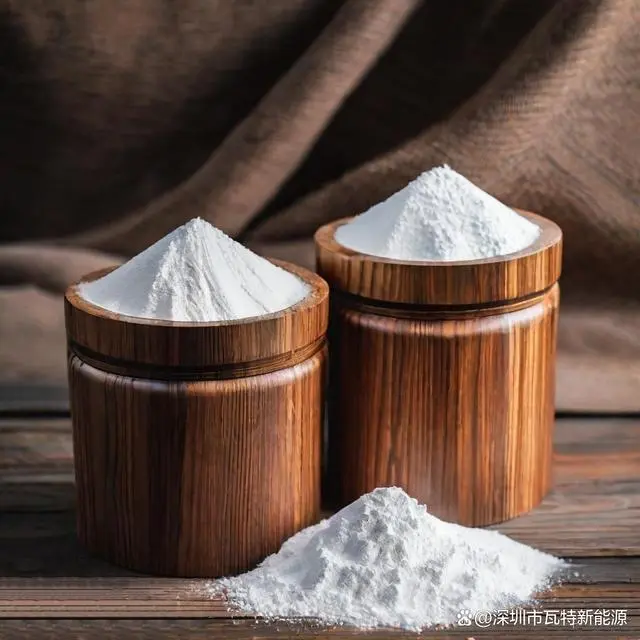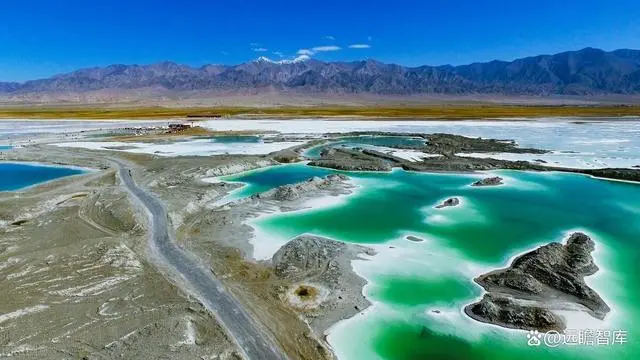Lithium carbonate is the provider of lithium ions in lithium batteries, and Li2CO3 occupies an important position in the industrial chain. As lithium carbonate futures products are about to be launched, this article will introduce the basic knowledge of lithium carbonate.
Basic properties of Li2CO3
Lithium carbonate is an inorganic compound with the chemical formula Li2CO3 and a molecular weight of 73.89. It is a colorless monoclinic crystal, slightly soluble in water and dilute acid, and insoluble in ethanol and acetone. Carbonates with lower thermal stability than other elements of the same group in the periodic table do not deliquesce in the air and can be obtained by adding sodium carbonate to lithium sulfate or lithium oxide solution. When carbon dioxide is introduced into the aqueous solution, it can be converted into acid salt and hydrolyzed by boiling. It is used as a raw material for ceramics, glass, ferrite, etc., and components are sprayed with silver paste, etc. It is also used medically to treat depression.

Classification and uses of lithium carbonate
Lithium carbonate is divided into industrial grade Li2CO3 and battery grade lithium carbonate according to different contents. Among them, industrial grade Li2CO3 can be used to prepare energy storage lithium iron phosphate and lithium manganate products, and are widely used in glass, ceramics, synthetic rubber, medicine and other industries; battery grade lithium carbonate is generally used to prepare lithium cobalt oxide, medium and low nickel Nternary materials, power lithium iron phosphate and other products.
Distribution characteristics and production process of lithium carbonate
Lithium carbonate products are highly dependent on resources and have strong regional characteristics. In East China, lithium extraction from lepidolite ore and lithium extraction from waste materials are mainly concentrated in Jiangxi Province; the southwest region is the main production area for lithium extraction from ores with Sichuan Province as the core; and the northwest region is brine based on the salt lake resources of Qinghai Province. Lithium extraction area.
Due to different sources of raw materials, the production processes of Li2CO3 are also quite different. The development of the lithium extraction process from spodumene is relatively mature, with a high lithium recovery rate and low entry barriers. Mainstream technology companies are continuing to increase recovery rates, reduce ore unit consumption, and expand production capacity through technical transformation.

In terms of lithium extraction technology from salt lake brine, due to the different resource endowments of salt lakes in my country, the magnesium-lithium ratio varies greatly. Therefore, the lithium extraction technology used by each salt lake needs to meet its own resource conditions and is not universal. The adsorption method currently used in Qarhan Salt Lake can produce battery-grade lithium carbonate in small batches. Dongtai Jinai Salt Lake, due to its low magnesium-lithium ratio, can produce quasi-battery-grade products and enter some battery material supply chains. At present, there is no industrial lithium extraction technology that can adapt to all salt lake brine types. The lithium extraction technology has a single applicability. Only by comprehensively applying different lithium extraction technologies can the lithium resources in salt lakes be recovered more efficiently.
Overview of lithium carbonate upstream and downstream
Lithium carbonate is in the middle and upstream processing links in the industrial chain. The upstream raw materials are lithium resources such as lithium ore, lepidolite, and brine. The direct downstream products are lithium battery cathode materials (lithium iron phosphate, ternary materials, lithium cobalt oxide, and manganese acid). Lithium), glass, ceramics, rubber and other industries. Among them, cathode materials are the largest direct downstream industry of Li2CO3, accounting for about 84.2%. Depending on the cathode material product, its unit consumption of lithium carbonate is 0.2-0.4 tons. No wait.
Lithium carbonate cost structure
The cost of producing lithium carbonate from different raw materials varies greatly.
To extract lithium from brine, the cost of salt lake brine is 3,000-4,000 yuan/ton. Different salt lake processes have different processes, and the approximate cost is within 20,000 yuan/ton – 40,000 yuan/ton. When extracting lithium from spodumene, based on a lithium concentrate with a lithium oxide content of 6%, 8 tons of lithium concentrate can produce 1 ton of lithium carbonate. The cost of raw materials fluctuates with the price of lithium concentrate. Lithium is extracted from lepidolite. The lithium oxide content in lepidolite is low. Considering the yield issue of 2%-3.5% lepidolite ore, 17-20 tons are needed to produce 1 ton of lithium carbonate. The cost of raw materials fluctuates with the price fluctuation of lepidolite.
Development overview of Li2CO3 industry
Lithium carbonate products are in the growth stage. As supply growth will rise, the industry will mature in a few years. It’s hard to get upstream raw materials for lithium carbonate. Companies need high operating capital, and the industry has a high barrier to entry. Listed companies, state-owned enterprises, and joint ventures account for a large proportion. Recent years have seen domestic lithium carbonate firms expand capacity. The key factors are acquisitions, shareholdings, and the growth of leading companies. The main way for downstream enterprises to extend upward. In recent years, small and medium-sized enterprises have faced instability. Some have now shifted to OEM production.
Changes in supply and demand structure of Li2CO3
In terms of the scale of domestic lithium carbonate production enterprises in my country, the number of enterprises with a production capacity of less than 20,000 tons/year accounts for about 75%. The difficulty in obtaining raw materials and technical level are factors that restrict the scale of enterprise production capacity. The main application field of lithium carbonate in my country is the lithium battery industry, and its consumption proportion of lithium carbonate is increasing year by year. The development of lithium carbonate products is inseparable from the lithium battery industry.
From the perspective of supply and demand structure, my country’s lithium carbonate supply and demand pattern has changed many times. From the perspective of the past five years, my country’s lithium carbonate industry has turned from oversupply to tight supply. 2020 is the time when the industry’s supply and demand structure changes. In 2020, policies will favor the development of end-use industries and drive the concentration of midstream material companies into production.
However, the long production cycle of lithium carbonate devices has caused the increase in domestic supply to be slower than the growth in demand. 2022 is the last year for new energy subsidies. In the second half of the year, terminal industries are actively producing and selling, and buyers are rushing to buy goods in advance, driving the supply of lithium salt spot market to continue to tighten. At the beginning of 2023, terminal consumption will be halved, all links in the industrial chain will enter the destocking stage, and the shortage of lithium carbonate will be significantly alleviated.
Lithium carbonate import market
my country’s lithium resource reserves are abundant, but they are unevenly distributed and difficult to mine. Lithium carbonate imports are another channel for supply. In recent years, my country’s dependence on lithium carbonate imports has gradually increased to about 30%. As the main producing countries of lithium carbonate products, Chile and Argentina account for more than 97% of my country’s total lithium carbonate imports, with Chilean sources accounting for nearly 90%. Nearly 80% of my country’s imported lithium carbonate is imported from companies in East China, and driven by rising demand, the proportion of imports by companies in Shanghai, Fujian and Guangdong has increased year by year.
Lithium carbonate price changes
In recent years, the lithium carbonate market price has shown the characteristics of a wide price span and accelerated price fluctuations. Supply and demand, cost, policy, funding, news, etc. are all important factors in market price changes. Around 2015, the supply and demand of the domestic lithium carbonate industry were both weak. In 2016, the gradual development of new energy vehicles drove up demand, and the price of lithium carbonate rose to about 170,000 yuan/ton. There was an oversupply of products from 2018 to 2020, and the price of lithium carbonate has been falling. In mid-2020, the price fell to about 40,000 yuan/ton.
With favorable policies, increased consumption, and improved demand in the industrial chain, market prices will begin a two-and-a-half-year upward trend after mid-2020. In mid-November 2022, the market price of lithium carbonate exceeded 600,000 yuan/ton. Subsequently, as the terminal subsidy policy was about to end and the buyer’s market replenishment sentiment weakened, the price of lithium carbonate peaked and fell. Within 5 months, the price of lithium carbonate fell to below 150,000 yuan/ton. The price fell below the cost line, and in late April the price was adjusted to about 300,000 yuan/ton.
The future development of Li2CO3
The lithium carbonate and downstream industries are relatively demand-oriented industries, and changes in the terminal consumer market directly affect the upstream and midstream product markets in the industrial chain. Looking to the future, the development of terminal new energy vehicles and energy storage markets is an important factor affecting the price, profit, and supply of lithium carbonate products. As the development of lithium resources at home and abroad progresses, the planned production capacity of lithium carbonate is gradually released, and the supply structure will become looser; the domestic terminal new energy vehicle and energy storage markets will continue to develop in the next few years until demand becomes saturated, and lithium batteries and new energy storage markets will continue to develop.
The export of end products such as energy vehicles and energy storage batteries is another development direction for growing demand. In the long term, the supply and demand structure will stabilize, and the price fluctuation space of lithium carbonate is expected to gradually narrow. However, it should be noted that in recent years, the new energy industry has attracted a lot of attention, and the lithium carbonate link is also the focus of capital attention. The impact of market mentality on prices has gradually strengthened; in addition, the speed of technological innovation in the new energy industry continues to increase, and sodium batteries and hydrogen fuels Batteries and other alternatives are developing rapidly. How the battery industry changes in the future will affect the development of lithium batteries and thus the demand for lithium carbonate.
